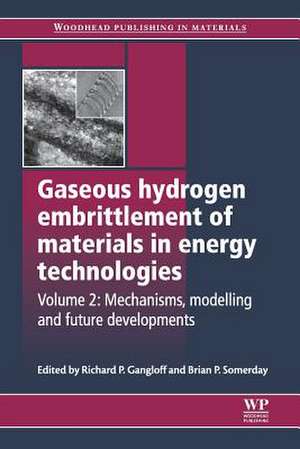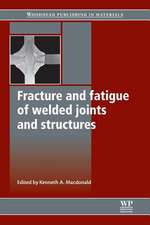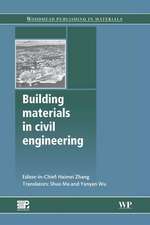Gaseous Hydrogen Embrittlement of Materials in Energy Technologies: Mechanisms, Modelling and Future Developments: Woodhead Publishing Series in Metals and Surface Engineering
Editat de Richard P Gangloff, Brian P Somerdayen Limba Engleză Paperback – 18 aug 2016
- Summarises the wealth of recent research on understanding and dealing with the safety, durability, performance and economic operation of using gaseous hydrogen at high pressure
- Chapters review mechanisms of hydrogen embrittlement including absorption, diffusion and trapping of hydrogen in metals
- Analyses ways of modelling hydrogen-induced damage and assessing service life
| Toate formatele și edițiile | Preț | Express |
|---|---|---|
| Paperback (2) | 960.56 lei 5-7 săpt. | |
| ELSEVIER SCIENCE – 18 aug 2016 | 960.56 lei 5-7 săpt. | |
| ELSEVIER SCIENCE – 18 aug 2016 | 1426.19 lei 5-7 săpt. |
Din seria Woodhead Publishing Series in Metals and Surface Engineering
- 24%
 Preț: 898.37 lei
Preț: 898.37 lei - 9%
 Preț: 1028.21 lei
Preț: 1028.21 lei - 24%
 Preț: 1044.05 lei
Preț: 1044.05 lei - 24%
 Preț: 1339.97 lei
Preț: 1339.97 lei - 23%
 Preț: 1227.85 lei
Preț: 1227.85 lei - 9%
 Preț: 1136.94 lei
Preț: 1136.94 lei - 24%
 Preț: 1165.93 lei
Preț: 1165.93 lei - 9%
 Preț: 812.20 lei
Preț: 812.20 lei - 9%
 Preț: 1396.45 lei
Preț: 1396.45 lei - 9%
 Preț: 810.22 lei
Preț: 810.22 lei - 9%
 Preț: 1140.04 lei
Preț: 1140.04 lei - 29%
 Preț: 1334.26 lei
Preț: 1334.26 lei - 24%
 Preț: 1130.31 lei
Preț: 1130.31 lei - 23%
 Preț: 864.86 lei
Preț: 864.86 lei - 9%
 Preț: 1135.38 lei
Preț: 1135.38 lei - 27%
 Preț: 1999.27 lei
Preț: 1999.27 lei - 24%
 Preț: 1561.85 lei
Preț: 1561.85 lei - 9%
 Preț: 1083.66 lei
Preț: 1083.66 lei - 24%
 Preț: 1624.39 lei
Preț: 1624.39 lei - 27%
 Preț: 1370.57 lei
Preț: 1370.57 lei - 24%
 Preț: 933.30 lei
Preț: 933.30 lei - 24%
 Preț: 1131.24 lei
Preț: 1131.24 lei - 9%
 Preț: 1158.68 lei
Preț: 1158.68 lei
Preț: 960.56 lei
Preț vechi: 1055.57 lei
-9% Nou
Puncte Express: 1441
Preț estimativ în valută:
183.81€ • 196.55$ • 153.25£
183.81€ • 196.55$ • 153.25£
Carte tipărită la comandă
Livrare economică 11-25 aprilie
Preluare comenzi: 021 569.72.76
Specificații
ISBN-13: 9780081016411
ISBN-10: 0081016417
Pagini: 520
Dimensiuni: 156 x 234 x 27 mm
Greutate: 0.72 kg
Editura: ELSEVIER SCIENCE
Seria Woodhead Publishing Series in Metals and Surface Engineering
ISBN-10: 0081016417
Pagini: 520
Dimensiuni: 156 x 234 x 27 mm
Greutate: 0.72 kg
Editura: ELSEVIER SCIENCE
Seria Woodhead Publishing Series in Metals and Surface Engineering
Cuprins
Contributor contact details
Introduction
Part I: Mechanisms of hydrogen interactions with metals
Chapter 1: Hydrogen adsorption on the surface of metals
Abstract:
1.1 Introduction
1.2 Adsorption effect
1.3 Elementary processes in adsorption
1.4 The structure of the H–Me adsorption complex
1.5 Kinetic equations and equilibrium
1.6 Conclusions
Chapter 2: Analysing hydrogen in metals: bulk thermal desorption spectroscopy (TDS) methods
Abstract:
2.1 Introduction
2.2 Principle of thermal desorption spectroscopy (TDS) measurements
2.3 Experimental aspects of thermal desorption spectroscopy (TDS)
2.4 Complementary techniques
2.5 Conclusion
Chapter 3: Analyzing hydrogen in metals: surface techniques
Abstract:
3.1 Introduction
3.2 Available techniques for analyzing hydrogen
3.3 Methods for analyzing hydrogen in metals: basic principles
3.4 Applications of hydrogen analysis methods
3.5 Ion beam-based methods
3.6 Conclusion
Chapter 4: Hydrogen diffusion and trapping in metals
Abstract:
4.1 Introduction: hydrogen uptake
4.2 Solubility of hydrogen in metals
4.3 Principles of hydrogen diffusion and trapping
4.4 Modelling of hydrogen diffusion and trapping
4.5 Measurement of hydrogen diffusion
4.6 Hydrogen diffusion data
4.7 Conclusions
4.8 Acknowledgements
Chapter 5: Control of hydrogen embrittlement of metals by chemical inhibitors and coatings
Abstract:
5.1 Introduction
5.2 Chemical barriers to hydrogen environment embrittlement (HEE): gaseous inhibitors
5.3 Physical barriers to hydrogen environment embrittlement (HEE)
5.4 Conclusions and future trends
Chapter 6: The role of grain boundaries in hydrogen induced cracking (HIC) of steels
Abstract:
6.1 Introduction: modes of cracking
6.2 Impurity effects
6.3 Temper embrittlement and hydrogen
6.4 Tempered-martensite embrittlement and hydrogen
6.5 Future trends
6.6 Conclusions
Chapter 7: Influence of hydrogen on the behavior of dislocations
Abstract:
7.1 Introduction
7.2 Dislocation motion
7.3 Evidence for hydrogen dislocation interactions
7.4 Discussion
7.5 Conclusions
7.6 Acknowledgements
Part II: Modelling hydrogen embrittlement
Chapter 8: Modeling hydrogen induced damage mechanisms in metals
Abstract:
8.1 Introduction
8.2 Pros and cons of proposed mechanisms
8.3 Evolution of decohesion models
8.4 Evolution of shear localization models
8.5 Summary
8.6 Conclusions
8.7 Acknowledgements
Chapter 9: Hydrogen effects on the plasticity of face centred cubic (fcc) crystals
Abstract:
9.1 Introduction and scope
9.2 Study of dynamic interactions and elastic binding by static strain ageing (SSA)
9.3 Modelling in the framework of the elastic theory of discrete dislocations
9.4 Experiments on face centred cubic (fcc) single crystals oriented for single glide
9.5 Review of main conclusions
9.6 Future trends
Chapter 10: Continuum mechanics modeling of hydrogen embrittlement
Abstract:
10.1 Introduction
10.2 Basic concepts
10.3 Crack tip fields: asymptotic elastic and plastic solutions
10.4 Crack tip fields: finite deformation blunting predictions
10.5 Application of crack tip fields and additional considerations
10.6 Stresses around dislocations and inclusions
10.7 Conclusions
10.8 Acknowledgement
Chapter 11: Degradation models for hydrogen embrittlement
Abstract:
11.1 Introduction
11.2 Subcritical intergranular cracking under gaseous hydrogen uptake
11.3 Subcritical ductile cracking: gaseous hydrogen exposure at pressures less than 45 MPa or internal hydrogen
11.4 Discussion
11.5 Conclusions
11.6 Acknowledgments
Chapter 12: Effect of inelastic strain on hydrogen-assisted fracture of metals
Abstract:
12.1 Introduction
12.2 Hydrogen embrittlement (HE) processes and assumptions
12.3 Hydrogen damage models and assumptions
12.4 Diffusion with dynamic trapping
12.5 Discussion
12.6 Conclusions
12.8 Appendix: nomenclature
Chapter 13: Development of service life prognosis systems for hydrogen energy devices
Abstract:
13.1 Introduction
13.2 Current techniques for control of cracking in safety critical structures
13.3 Future developments in crack control using prognostic systems
13.4 Prognostic systems for crack control in hydrogen energy technologies
13.5 Potential future research areas
13.6 Conclusions
Part III: The future
Chapter 14: Gaseous hydrogen embrittlement of high performance metals in energy systems: future trends
Abstract:
14.1 Introduction
14.2 Theory and modeling
14.3 Nanoscale processes
14.4 Dynamic crack tip processes
14.5 Interfacial effects of hydrogen
14.6 Measurement of localized hydrogen concentration
14.7 Loading mode effects
14.8 Hydrogen permeation barrier coatings
14.9 Advances in codes and standards
14.10 Conclusions
Index
Introduction
Part I: Mechanisms of hydrogen interactions with metals
Chapter 1: Hydrogen adsorption on the surface of metals
Abstract:
1.1 Introduction
1.2 Adsorption effect
1.3 Elementary processes in adsorption
1.4 The structure of the H–Me adsorption complex
1.5 Kinetic equations and equilibrium
1.6 Conclusions
Chapter 2: Analysing hydrogen in metals: bulk thermal desorption spectroscopy (TDS) methods
Abstract:
2.1 Introduction
2.2 Principle of thermal desorption spectroscopy (TDS) measurements
2.3 Experimental aspects of thermal desorption spectroscopy (TDS)
2.4 Complementary techniques
2.5 Conclusion
Chapter 3: Analyzing hydrogen in metals: surface techniques
Abstract:
3.1 Introduction
3.2 Available techniques for analyzing hydrogen
3.3 Methods for analyzing hydrogen in metals: basic principles
3.4 Applications of hydrogen analysis methods
3.5 Ion beam-based methods
3.6 Conclusion
Chapter 4: Hydrogen diffusion and trapping in metals
Abstract:
4.1 Introduction: hydrogen uptake
4.2 Solubility of hydrogen in metals
4.3 Principles of hydrogen diffusion and trapping
4.4 Modelling of hydrogen diffusion and trapping
4.5 Measurement of hydrogen diffusion
4.6 Hydrogen diffusion data
4.7 Conclusions
4.8 Acknowledgements
Chapter 5: Control of hydrogen embrittlement of metals by chemical inhibitors and coatings
Abstract:
5.1 Introduction
5.2 Chemical barriers to hydrogen environment embrittlement (HEE): gaseous inhibitors
5.3 Physical barriers to hydrogen environment embrittlement (HEE)
5.4 Conclusions and future trends
Chapter 6: The role of grain boundaries in hydrogen induced cracking (HIC) of steels
Abstract:
6.1 Introduction: modes of cracking
6.2 Impurity effects
6.3 Temper embrittlement and hydrogen
6.4 Tempered-martensite embrittlement and hydrogen
6.5 Future trends
6.6 Conclusions
Chapter 7: Influence of hydrogen on the behavior of dislocations
Abstract:
7.1 Introduction
7.2 Dislocation motion
7.3 Evidence for hydrogen dislocation interactions
7.4 Discussion
7.5 Conclusions
7.6 Acknowledgements
Part II: Modelling hydrogen embrittlement
Chapter 8: Modeling hydrogen induced damage mechanisms in metals
Abstract:
8.1 Introduction
8.2 Pros and cons of proposed mechanisms
8.3 Evolution of decohesion models
8.4 Evolution of shear localization models
8.5 Summary
8.6 Conclusions
8.7 Acknowledgements
Chapter 9: Hydrogen effects on the plasticity of face centred cubic (fcc) crystals
Abstract:
9.1 Introduction and scope
9.2 Study of dynamic interactions and elastic binding by static strain ageing (SSA)
9.3 Modelling in the framework of the elastic theory of discrete dislocations
9.4 Experiments on face centred cubic (fcc) single crystals oriented for single glide
9.5 Review of main conclusions
9.6 Future trends
Chapter 10: Continuum mechanics modeling of hydrogen embrittlement
Abstract:
10.1 Introduction
10.2 Basic concepts
10.3 Crack tip fields: asymptotic elastic and plastic solutions
10.4 Crack tip fields: finite deformation blunting predictions
10.5 Application of crack tip fields and additional considerations
10.6 Stresses around dislocations and inclusions
10.7 Conclusions
10.8 Acknowledgement
Chapter 11: Degradation models for hydrogen embrittlement
Abstract:
11.1 Introduction
11.2 Subcritical intergranular cracking under gaseous hydrogen uptake
11.3 Subcritical ductile cracking: gaseous hydrogen exposure at pressures less than 45 MPa or internal hydrogen
11.4 Discussion
11.5 Conclusions
11.6 Acknowledgments
Chapter 12: Effect of inelastic strain on hydrogen-assisted fracture of metals
Abstract:
12.1 Introduction
12.2 Hydrogen embrittlement (HE) processes and assumptions
12.3 Hydrogen damage models and assumptions
12.4 Diffusion with dynamic trapping
12.5 Discussion
12.6 Conclusions
12.8 Appendix: nomenclature
Chapter 13: Development of service life prognosis systems for hydrogen energy devices
Abstract:
13.1 Introduction
13.2 Current techniques for control of cracking in safety critical structures
13.3 Future developments in crack control using prognostic systems
13.4 Prognostic systems for crack control in hydrogen energy technologies
13.5 Potential future research areas
13.6 Conclusions
Part III: The future
Chapter 14: Gaseous hydrogen embrittlement of high performance metals in energy systems: future trends
Abstract:
14.1 Introduction
14.2 Theory and modeling
14.3 Nanoscale processes
14.4 Dynamic crack tip processes
14.5 Interfacial effects of hydrogen
14.6 Measurement of localized hydrogen concentration
14.7 Loading mode effects
14.8 Hydrogen permeation barrier coatings
14.9 Advances in codes and standards
14.10 Conclusions
Index
Recenzii
"This book is a worthwhile purchase for anybody with a serious interest in the area of hydrogen embrittlement. It is a valuable reference for scientists and engineers alike, whether they are university students or experienced professionals." --Materials World










